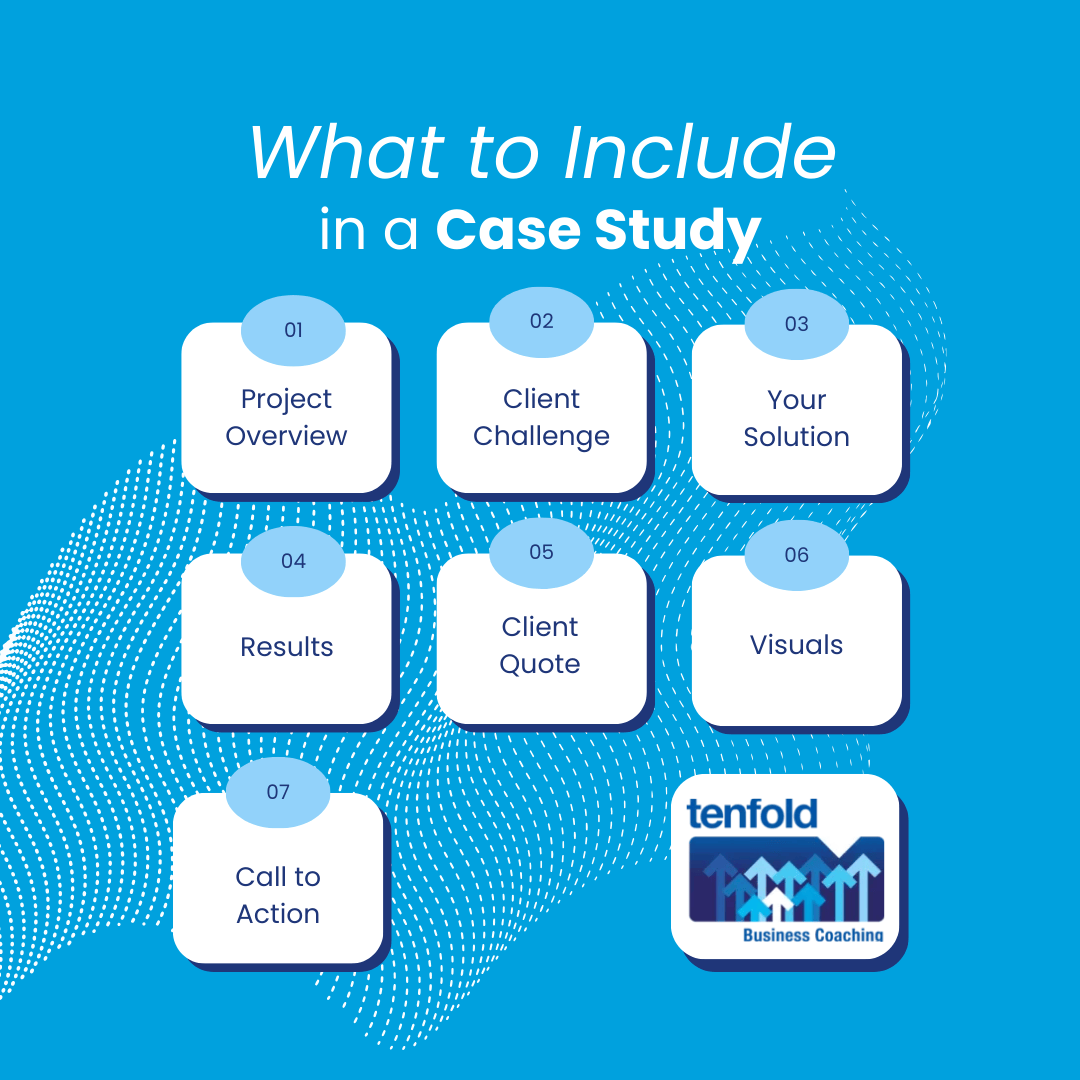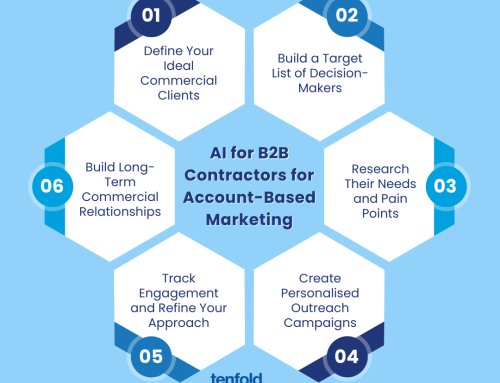Case Studies for B2B Contractors to Win Work: Template, Examples, Checklist
For growing businesses in the construction, manufacturing, and distribution sectors, winning new work often comes down to building trust. Prospective clients want proof that you can deliver results, solve problems, and operate professionally. That’s where case studies come in. In this guide, I will walk you through how to create compelling case studies that attract Tier 2 and Tier 3 commercial clients, real estate investment trusts (REITs), and institutional buyers, all without relying on paid advertising. You will learn what to include, what to avoid, and how to use case studies as a powerful business-to-business prospecting tool. I will also share a checklist and examples tailored specifically to contractors and owner-operated businesses.
I am Ashley Thomson, a business coach at Tenfold Business Coaching. I work with established businesses across Australia on a one-on-one basis, helping business owners grow their companies in a sustainable and profitable way. My clients include builders, fabricators, wholesalers, and tradies who have moved beyond the startup stage and are now focused on securing better work and building stronger, more effective teams. With over ten years of experience in business coaching services, I have seen firsthand how the right marketing tools, such as case studies, can open doors to high-value contracts and create long-term partnerships.
What Is a Case Study and Why It Works for B2B Prospecting
A case study is a real-world example of a project your business has completed. It narrates how you addressed a problem for a client, what results you achieved, and how you delivered value. For B2B contractors, case studies are particularly effective because they speak directly to the concerns of commercial buyers. These decision-makers want to see evidence of capability, reliability, and professionalism.
Testimonials, unlike case studies, are often brief and vague, while case studies offer vital context. They showcase your process, your thinking, and your outcomes. When done well, they establish your business as a trusted expert – a key factor for growth, according to every small business coach.
Best Practices for Writing Case Studies That Win Work
Start With the Client’s Challenge
What challenges were they experiencing before they engaged your services? Please be specific. For example, you might say, ‘A Tier 2 builder required a reliable HVAC subcontractor to meet strict deadlines on a multi-storey education facility.”
Explain Your Approach
Describe how you scoped the project, managed timelines, coordinated with other trades, or overcame site constraints. This is where you demonstrate your expertise and professionalism.
Share Measurable Results
Did you assist the client in reducing costs, enhancing efficiency, or meeting compliance requirements? Use specific figures wherever possible. For example, you might say, “Delivered the project two weeks early, saving the client $18,000 in labour costs and penalties.”
Include Visuals
Before-and-after photographs, site plans, or progress shots help to bring the story to life. They also make your case study more engaging and easier for readers to skim through.
Keep it Concise
Aim for 400 to 600 words for each case study. Make sure it is long enough to demonstrate depth, but short enough to keep the reader engaged.
What to Include in a Case Study
Project Overview
Please provide a detailed description of the client, including their background and industry. Also, specify the type of project being undertaken, whether it’s development, consulting, research, or another category, and outline the overall scope of work, such as project objectives, key deliverables, and any important milestones or deadlines.
Client Challenge
Describe the specific problem or need that prompted them to seek out and engage with your business. Explain the circumstances, challenges, or unmet needs that drove their decision to connect with your services or products.
Your Solution
Explain in detail what you did during the process, including the specific steps you took, how you carried out each step, and the overall approach you used. Additionally, describe why you believe your method was effective and how it contributed to achieving the desired outcome.
Results
Highlight the key outcomes achieved through the project, such as significant time savings, notable cost reductions, or marked improvements in performance metrics. Provide detailed examples or statistics where possible to illustrate these benefits clearly.
Client Quote
If possible, include a short testimonial from the client to reinforce the credibility of your service or product. This additional endorsement can help to build trust with potential customers or stakeholders by providing a real-world example of satisfaction and positive experience.
Visuals
In addition to the existing content, consider adding relevant images or diagrams that visually support and enhance the narrative. These visual elements can help clarify complex ideas, engage the reader more effectively, and provide a more comprehensive understanding of the topic discussed.
Call to Action
Finish your message with a strong call to action that urges the reader to contact you directly or learn more about your services. This should inspire them to engage further with your brand.
What Not to Do in a Case Study
Don’t Be Vague
Statements like “We did a great job” or “The client was happy” don’t build trust. Instead, it is more effective to provide specific details and factual evidence that support these claims. For example, mention concrete achievements, project milestones reached, or positive feedback received that can be quantified or qualified. Being detailed and transparent helps to establish credibility and fosters trust with your audience or clients, as they can see tangible proof of your efforts and results.
Avoid Jargon
To ensure your message is understood, especially for those who may not be familiar with specialised or technical terminology, it is crucial to use language that is clear, simple, and accessible. Avoid jargon whenever possible, and consider providing brief explanations or definitions for any technical terms that are necessary. By doing so, you help your audience better grasp your message and engage more effectively with your content. Clear and accessible language fosters better communication and ensures that your ideas reach and resonate with everyone.
Don’t Oversell
Case studies should be honest and grounded in reality, providing a clear and accurate portrayal of the situation. If you exaggerate results or present them in a misleading manner, savvy buyers will quickly see through it, damaging your credibility and potentially harming your reputation in the long run. Therefore, it is essential to ensure that all case studies are truthful, well-founded, and transparent to build trust with your audience and demonstrate genuine value.
Skip the Fluff
When presenting your ideas or proposals, it is important to focus primarily on the client’s specific problem and clearly articulate how your solution addresses it. To maintain the audience’s interest and ensure clarity, avoid lengthy introductions or providing a generic history of your company that doesn’t directly contribute to the main message. Instead, be concise and stay on point to effectively communicate the value you can offer.
Don’t Forget the Audience
Create content that speaks directly to the specific type of client you wish to attract. If your target audience includes REITs or Tier 2 builders, make sure to customise your examples and messaging to resonate with their needs, challenges, and interests. This tailored approach will help you establish credibility and attract the right clients who are most likely to benefit from and value your services.
Using Case Studies for B2B Prospecting
Once you’ve created a few strong case studies, it’s time to put them to work. Case studies are versatile tools that can be used across multiple channels to attract and convert leads.
Add Them to Your Website
Consider creating a dedicated section on your website labelled ‘Projects” or “Case Studies.’ This section should be well-organised and visually appealing, with each entry presented in a clear, concise manner. For every project or case study, include essential details such as a brief description of the work, key achievements, and any relevant images or multimedia. Additionally, ensure that each entry includes up-to-date contact information so interested parties can easily reach out for further discussion or inquiries.
Use Them in Proposals
When bidding for new work, it is highly beneficial to include relevant case studies that showcase your previous experiences and successes. This helps to demonstrate your track record and build trust with potential clients.
Share Them on LinkedIn
Share engaging snippets or summaries of your case study, along with a direct link to the full version. Remember to tag relevant clients or collaborators in your posts to significantly increase visibility and reach a broader audience. This strategy not only promotes your work effectively but also fosters stronger professional relationships.
Include Them in Email Outreach
When reaching out to potential clients, it is highly effective to reference a case study that closely resembles their specific business or the type of project they are interested in. This approach not only demonstrates your understanding of their industry but also helps to establish credibility and trust right from the initial contact.
Train Your Team
Ensure that your sales staff and estimators are well-trained in effectively using case studies during conversations and presentations. This will help them demonstrate real-world examples and proof of success, increasing your chances of closing deals and building trust with potential clients.
Case Study Template for B2B Contractors
Here’s a simple structure you can follow:
Project Name: [e.g., HVAC Installation for Tier 2 Builder – Education Facility]
Client: [Builder name, sector]
Challenge: [Brief description of the problem or need]
Solution: [Your approach, key actions taken]
Results: [Quantifiable outcomes, client feedback]
Visuals: [Photos, diagrams, plans]
Call to Action: [Prompt to contact or learn more]
Example Case Study: Solar Installation for REIT-Owned Retail Centre
Client: Tier 2 commercial builder working on behalf of a REIT
Challenge: The client needed a solar contractor who could install a 100kW system across multiple rooftops with minimal disruption to tenants
Solution: Our team conducted a site audit, coordinated with property managers, and staged installation over weekends to avoid downtime. We used high-efficiency panels and integrated monitoring systems to meet compliance and reporting requirements
Results: Completed installation in 12 days, zero tenant complaints, and system performance exceeded expectations by 8%t in the first quarter
Client Quote: “Professional, proactive, and easy to work with. We chose the right contractor for the job”
Final Thoughts from a Business Coach
Case studies aren’t just marketing fluff. They’re strategic tools that help growing businesses win better work and build trust with commercial clients. As a business coach, I’ve seen how well-crafted case studies can open doors to new sectors, strengthen your brand, and support long-term growth. If you’re ready to take your prospecting to the next level, start with your own success stories. They’re your most powerful asset.
If you’d like help developing case studies or refining your B2B marketing strategy, Tenfold’s business coaching services are designed to support established, owner-operated businesses like yours. Let’s make your next win easier to land.
FAQs About Case Studies for B2B Contractors
How many case studies should I have?
Aim for three to five strong examples that reflect your best work. Quality matters more than quantity.
Can I write a case study if the client didn’t give a testimonial?
Yes. While a quote adds credibility, the case study can still be effective if it clearly shows the challenge, solution, and results.
Should I include pricing details?
Only if it adds value. For example, showing how you saved a client money or delivered under budget can be persuasive.
Can I use case studies in tender submissions?
Absolutely. Case studies are a powerful way to demonstrate capability and differentiate your business from competitors.
Do I need a professional writer?
Not necessarily. With guidance from a small business coach or business coaching services, you can develop a repeatable process for writing case studies in-house.




![Account-Based Marketing (ABM) for Contractors: Connect with Facilities & Property Managers [Template, Examples, Checklist]](https://tenfoldcoaching.com.au/wp-content/uploads/2025/09/Account-Based-Marketing-ABM-for-Contractors-Connect-with-Facilities-Property-Managers-Template-Examples-Checklist-500x383.png)

